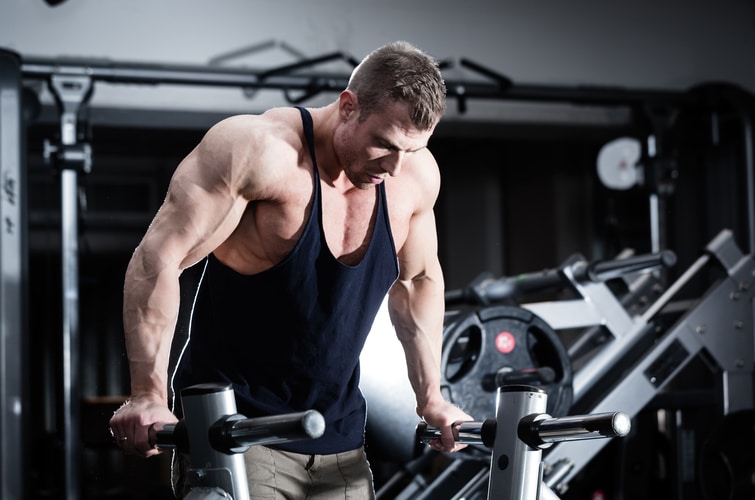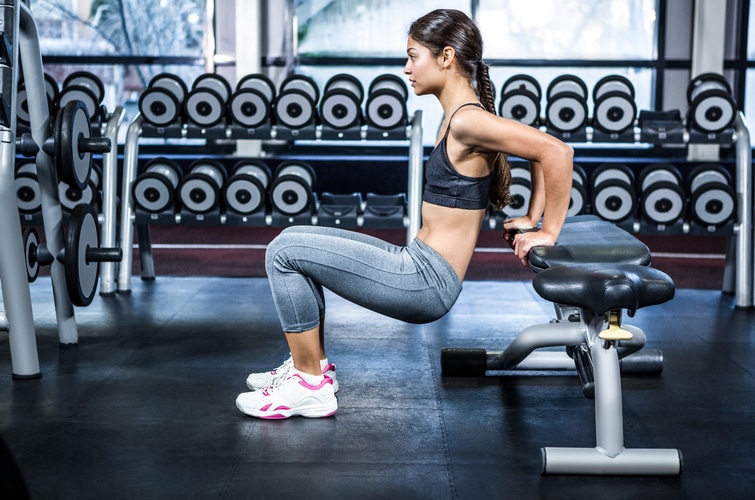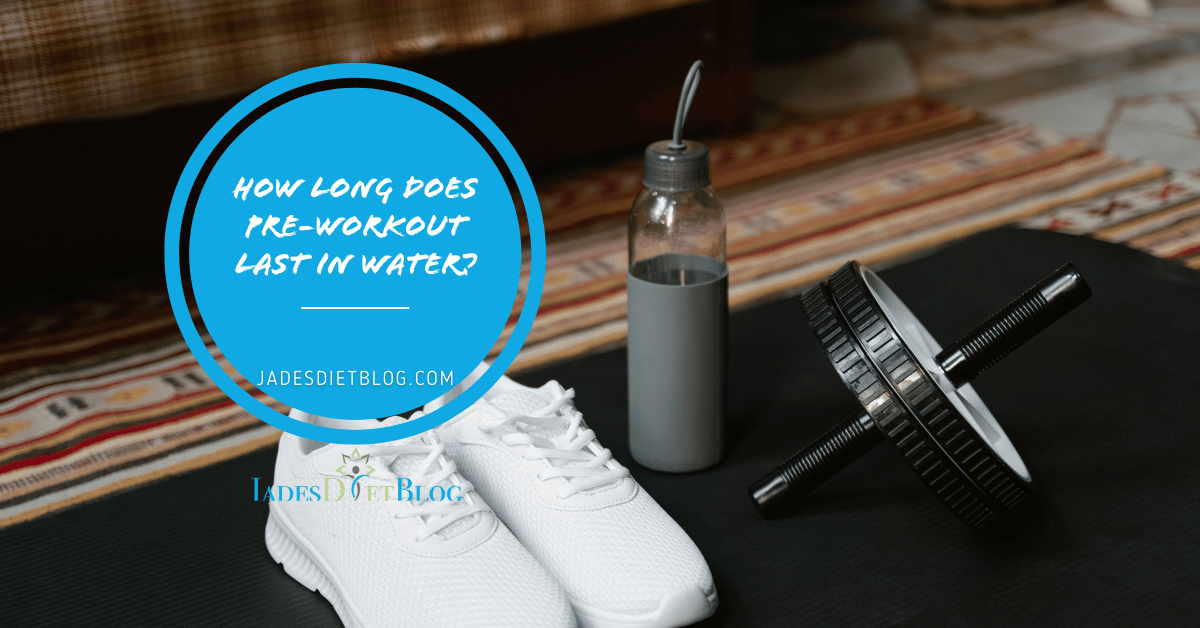Are you looking for a killer workout that you can do at home? If so, you may be interested in bench dips vs. dip exercises. Bench dips are a great way to work your chest and shoulder muscles, as well as your triceps. Dip exercises, on the other hand, are more effective when it comes to targeting your abdominal muscles.
Which is the best workout for you? It depends on your goals and the type of exercise you’re looking to perform. Read on to learn more about dips vs. bench dips. Check each one and choose the one that’s right for you!
Contents
What Is A Bench Dip?
Bench dips are a type of bodyweight exercise that targets muscles in your arms, shoulders, and chest. They are also known as triceps dips. Bench dips are a great way to work your chest and triceps, while the dip is a better workout for your arms and shoulders.
Bench dips are a great exercise for your chest and triceps. They work the muscles in your pecs and triceps by using gravity to pull the weight down towards your chest. This exercise is also good for building upper-body strength because it requires you to use large muscle groups in one movement.
Bench presses are performed by lying on the bench with upper arms extended overhead and legs bent, then lowering the torso until it's level with the bench surface. Triceps dips will have you positioned more upright, with your elbows under your shoulders and feet directly underneath you while chest dips will have you positioned more forward, with your elbows flared out and feet behind you.
To do a bench dip: Sit on the bench with feet flat on the ground, shoulder-width apart. Bend forward from the hips and place your hands flat on the bench above your thighs. Push the body up so that the upper torso, shoulders, and arms are all in line with the bench. Lower yourself down until your thighs are at or below the level of the bench, then press back up to starting position. Do six to eight reps per side.
What Is A Dip?

Dips are a compound exercise and a great workout as well for building muscle and strength. Dip workouts can be done at the gym or home with minimal equipment. The dip is a better workout for your arms and shoulders because it uses more weight and causes more muscle damage.
This exercise works the muscles in your biceps, triceps, shoulders, and back muscles. It also helps improve coordination and balance because you have to keep your body stable as you lower yourself into the dip position. The dip is a bodyweight version of the decline bench press.
The main muscle trained by a dip is the triceps. Other muscles that are targeted are the anterior deltoid of the shoulder, as well as the rhomboids of the back. The key to success with this exercise is to keep your back straight and chin down throughout the movement. Dip workouts can burn calories quickly, which is why they're an ideal choice for people looking to shed pounds or tone up their bodies.
To do a dip: Place hands on edge of a sturdy table or countertop and step or jump onto fingers (a variation is to place palms flat on the surface). Legs should be slightly bent, shoulders back, and head down; keep the spine straight (core engaged). Lower self until forearms touch or almost touch surface; raise self up using elbows and toes/fingers as handles. Do eight reps per side.
The Differences Between Bench Dips and Dip
Bench dips are a great way to isolate your pecs and build a bigger chest. The bench dips require less space than the dip, and they're also easier to do at home. Bench dips also offer a more complete chest workout because they involve weightlifting as well as cardio.
Dip workouts are great for toning your body and improving your overall fitness level. They're also great for building muscle endurance because you have to maintain good form for the entire duration of the workout. Dip workouts can be done with or without weights, so they're versatile and perfect for any level of exercise.
Bench dips are performed by placing the palms of your hands flat on the bench, with your body pressed firmly against the bench. You then lower yourself down until your chest is just below the surface of the bench. You then press back up and repeat.
Dip exercises are different because you hold onto an HG bar with both hands and lower yourself into a squat position before raising back up to the starting position. Some variations of dip exercises include handstand push-ups, weighted dips, and incline weighted dips.
Bench dips are a great way to work your triceps, but they may not be the best workout for you if you're looking to build muscle. Dip workouts are more effective at building muscle mass than bench press workouts. This is because dip workouts use several compound exercises that combine weightlifting and cardio, which is what's most effective at building muscle.
The Best Time Of Day To Do Bench Dips or Dip Workouts
There is no one-size-fits-all answer to this question, as the best time of day to do bench dips or dip workouts will vary depending on your fitness level and schedule. However, some popular times to do bench dips or dip workouts include morning or afternoon sessions because they're less hectic than evening or night sessions.
Additionally, if you have a busy work schedule, morning or afternoon sessions may be better because they allow you more time for other activities. There’s no definitive answer when it comes to which time of day is best for bench dips or dip workouts. However, there are a few general tips that can help you optimize your results:
-
Choose a time of day when you’re most energetic and motivated.
-
Avoid working out in the early morning or late at night, when your body is already fatigued.
-
Try to work out in intervals, alternating between bench dips and dip sets. This way, you'll keep your energy levels high and avoid getting too tired in the middle of your workout.

Benefits Of Bench Dips and Dip Workouts
There are several benefits to bench dips and dip workouts. As with most types of exercise, the key to maximizing the benefits of bench dips and dip exercises is variety. Mixing up your routine with different variations will keep your muscles guessing and maximize the growth potential. This includes incorporating both bench dips and dip variations into your weekly routine.
Here are some of the benefits that you can expect from incorporating these two popular workouts into your routine:
-
Increased Strength: Bench dips build strength by requiring you to use more weight than dip exercises, which in turn results in greater muscle activation and growth. Dip variations also offer countless ways to increase strength, including incline, reverse, or flat bench press variations.
-
Better Balance: While both exercises improve balance, only bench dipping develops overall balance while working all muscle groups in the body. This makes it an ideal exercise for those looking to improve their coordination and stability while working out.
-
Increased Cardio Capacity: Dip Exercise works large muscles such as the quads, hamstrings, and shoulders more than traditional cardio such as running or biking because they require more energy and resistance from the user. As a result, this type of exercise has been shown to improve cardio endurance significantly over time!
-
Increased Muscular Endurance: Bench dips and dip variations require you to use more muscle than traditional cardio exercises, which leads to greater muscular endurance.
Countless other benefits can be attained by incorporating bench dips and dip variations into your routine, so it is important to mix things up and find what works best for you. Schedule a consultation with a personal trainer and let them help you create a personalized routine that will help you achieve your goals.
Pros and Cons Of Both Workouts
There are a lot of people who are considering whether or not to do bench dips or dip workouts. So, in this article, we will compare the pros and cons of both workouts so that you can make the best decision for your needs.
Bench Dips
Pros:
-
The bench dip is a great workout for overall fitness because it targets your upper body.
-
It is also a great workout if you want to build muscle because it requires a lot of strength and stamina.
-
The bench dip is also good for toning your arms, chest, and shoulders because it works your muscles from different angles.
Cons:
-
However, the bench dip has some downsides too. One downside is that it can be dangerous if you don’t do it correctly. You could injure yourself if you don’t use enough weight or if you don’t go slowly enough.
-
Another downside is that it can be boring because most people only do one variation of the bench dip.
Dip Workouts
Pros:
-
The dip workout is a great way to get fit because it targets your entire body.
-
It also helps to build muscle and tone your body by working different muscles from different angles.
Cons:
-
One downside of the dip workout is that you have to be careful with how much weight you use because too much weight could cause injury.
-
Another downside of the dip workout is that it can be boring too.
The Risks Of Bench Dips and Dip Workouts
Bench dips and dip workouts can be incredibly dangerous if performed incorrectly. Improper form can lead to serious spinal cord injuries and even death. There are a few potential risks to consider when undertaking bench dips or dip workouts, including:

- Back pain – Due to the nature of the exercise, bench dips can place a great deal of pressure on the lower back. If done improperly or for too long, this may lead to back pain.
- Repetitive strain injury – Bench dips and other dip exercises can cause micro-tears in muscles and tendons as you lift your body weight repeatedly. These tears can lead to chronic muscle pain and weakness if not treated correctly.
- Neck strain – Like with back pain, lifting heavy weights with your head down can cause neck strain. If this occurs, it may be necessary to modify the exercise or stop completely until the neck pain subsides.
- Lower-body injury – Due to the weight you are lifting, bench dips and other dip exercises can place a lot of strain on the lower body. If you are not properly warmed up or if you do not have adequate core strength, this strain may lead to a lower-body injury.
- Overuse – Bench dips and other dip exercises can be very demanding on the muscles and tendons, which may lead to overuse if performed too frequently or for too long. If this occurs, you may experience muscle pain, weakness, and even tendon damage.
- Mental fatigue – Bench dips and other dip exercises can be very tiring, both physically and mentally. If you are not prepared for this type of workout, you may find yourself struggling to complete it without interruption.
How To Get The Most Out Of Bench Dip and Dip Workouts
If you're looking to get the most out of your bench dip and dip workouts, follow these tips.
Warm Up Your Body First
Before starting any workout, it's important to warm up your body. This will help reduce inflammation and improve blood flow to your muscles. Bench dips and dip workouts are no different – by warming up your muscles before starting, you'll be able to complete the workout with more intensity and achieve better results.
Use The Right Equipment
When using bench dips and dip machines, make sure that you use the correct weight. Start with a lightweight and increase the weight as needed until you reach the desired intensity level. Be careful not to overuse your muscles – if you use too much weight, you could injure yourself.
Add Resistance Training After Bench Dips & Dip Workouts
Adding resistance training after bench dips and dip workouts can help increase muscle growth and strength gains. Adding bench dips to an upper body workout will give you the progress you need especially in your chest and triceps. Try doing squats or lunges after your bench dips for an added boost of muscle-building power!
Take Breaks
After completing a bench dip or dip workout, take a few minutes to rest your muscles. This will allow them to recover and grow stronger.
Repeat The Workout As Needed
If you're looking to build muscle and strength, it's important to repeat the bench dip and dip workout as needed. This way, you'll be able to see consistent results over time.

Conclusion
If you're looking to add a little more muscle to your physique, one of the best exercises for that is bench dips. Bench dips are an excellent way to increase your strength while also toning your chest and arms.
Dip therapy, on the other hand, is great for people who want a more cardio-focused workout. The two exercises complement each other, and a good upper-body workout will include both. Both exercises offer similar benefits — they help you build muscle and burn fat — but dip therapy offers an added benefit: it helps you lose weight.
Which one should you choose? It depends on your goals and preferences. Ultimately, the best way to decide which type of workout is right for you is to try different exercises and see which ones work best for your goals.





